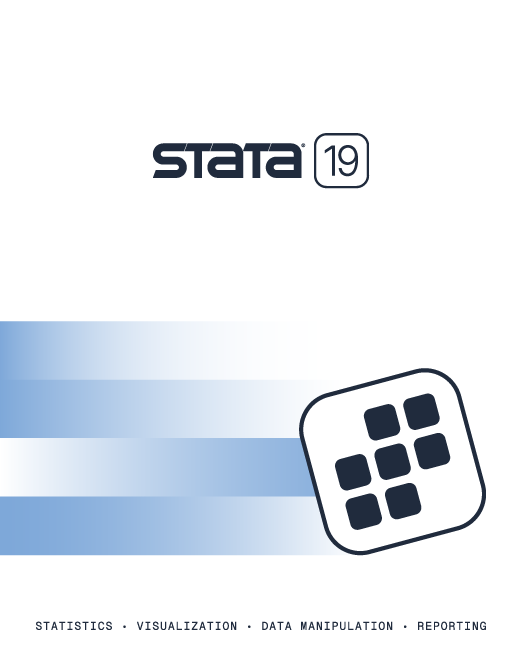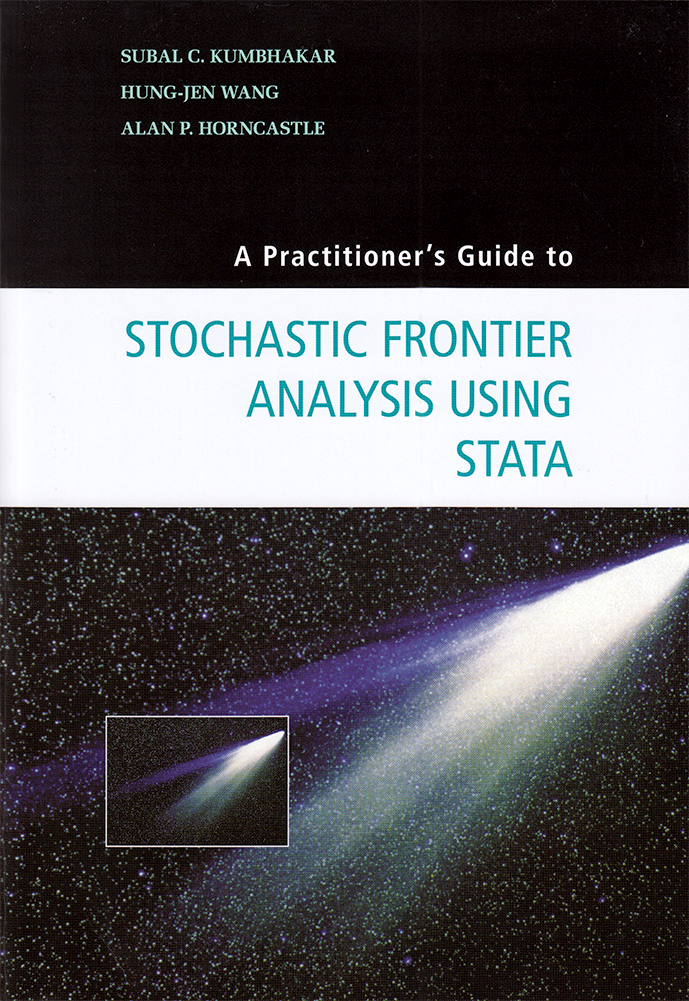

2025 Stata Conference • Nashville, TN • 31 July–01 August
A Practitioner's Guide to Stochastic Frontier Analysis Using Stata |
||||||||||||||||||||||||||||||||||||
 Click to enlarge See the back cover |

As an Amazon Associate, StataCorp earns a small referral credit from
qualifying purchases made from affiliate links on our site.
eBook not available for this title
eBook not available for this title |
|
||||||||||||||||||||||||||||||||||
Comment from the Stata technical groupA Practitioner's Guide to Stochastic Frontier Analysis Using Stata by Subal C. Kumbhakar, Hung-Jen Wang, and Alan P. Horncastle provides an excellent introduction to stochastic frontier analysis. This book provides exceptional introductions to beginning and advanced topics in this area and Stata examples using code written by the authors. After providing an introduction to the topic, the book provides an excellent survey of all the essential topics in the field. The book does a great job of making the basic economics and the basic statistics accessible to a broad audience without lowering the level or omitting important topics. The authors provide a nice mix of intuition, mathematics, and Stata examples. Professors, graduate students, and researchers will find this book useful in the classroom and for self-study in preparation for research projects. |
||||||||||||||||||||||||||||||||||||
Table of contentsView table of contents >> Preface
PART I GENERAL INFORMATION
1 Introduction
1.1 What This Book Is About
1.2 Who Should Read This Book? 1.3 The Structure of This Book 2 Production, Distance, Cost, and Profit Functions
2.1 Introduction
2.2 The Production Function and Technical Efficiency
2.2.1 Input-Oriented and Output-Oriented Technical Inefficiency
2.3 Statistics from Production Functions
2.2.2 Non-Neutral Technical Inefficiency
2.3.1 Homogeneity and Returns to Scale
2.4 Transformation of Production Functions 2.3.2 Substitutability 2.3.3 Separability 2.3.4 Technical Change 2.5 Functional Forms of Production Functions
2.5.1 The Cobb-Douglas (CD) Production Function
2.6 Multiple Output Production Technology (Distance Functions)
2.5.2 The Generalized Production Function (GPF) 2.5.3 The Transcendental Production Function 2.5.4 The Translog Production Function
2.6.1 Distance Functions
2.7 The Transformation Function Formulation
2.6.2 The Translog Input Distance Function 2.6.3 The Translog Output Distance Function
2.7.1 The Transformation Function with Inefficiency
2.8 Allocative Inefficiency
2.8.1 Cost Minimization and Allocative Inefficiency
2.9 The Indirect Production Function
2.8.2 Profit Maximization and Allocative Inefficiency
2.9.1 Modeling
PART II SINGLE EQUATION APPROACH: PRODUCTION, COST, AND
PROFIT
3 Estimation of Technical Efficiency in Production Frontier
Models Using Cross-Sectional Data
3.1 Introduction
3.2 Output-Oriented Technical Efficiency 3.3 Estimation Methods: Distribution-Free Approaches
3.3.1 Corrected OLS (COLS)
3.4 Estimation Methods: Maximum Likelihood Estimators
3.3.2 Corrected Mean Absolute Deviation (CMAD) 3.3.3 Thick Frontier Approach
3.4.1 A Skewness Test on OLS Residuals
3.5 Input-Oriented Technical Inefficiency 3.4.2 Parametric Distributional Assumptions 3.4.3 Half-Normal Distribution 3.4.4 Truncated-Normal Distribution 3.4.5 Truncated Distribution with the Scaling Property 3.4.6 The Exponential Distribution 3.6 Endogeneity and Input and Output Distance Functions 4 Estimation of Technical Efficiency in Cost Frontier Models
Using Cross-Sectional Data
4.1 Introduction
4.2 Input-Oriented Technical Inefficiency
4.2.1 Price Homogeneity
4.3 Estimation Methods: Distribution-Free Approaches
4.2.2 Monotonicity and Concavity
4.3.1 Corrected OLS
4.4 Estimation Methods: Maximum Likelihood Estimators
4.3.2 Cases with No or Little Variation in Input Prices 4.3.3 Thick Frontier Approach 4.3.4 Quantile-Regression-Based TFA
4.4.1 Skewness Test on OLS Residuals
4.5 Output-Oriented Technical Inefficiency
4.4.2 The Half-Normal Distribution 4.4.3 The Truncated-Normal, Scaling, and Exponential Models
4.5.1 Quasi-Fixed Inputs
4.5.2 Estimation Methods 5 Estimation of Technical Efficiency in Profit Frontier Models Using Cross-Sectional Data
5.1 Introduction
5.2 Output-Oriented Technical Inefficiency 5.3 Estimation Methods: Distribution-Free Approaches 5.4 Estimation Methods: Maximum Likelihood Estimators 5.5 Input-Oriented Technical Inefficiency 5.6 Estimation Methods: Distribution-Free Approaches 5.7 Estimation Methods: Maximum Likelihood Estimators PART III SYSTEM MODELS WITH CROSS-SECTIONAL DATA
6 Estimation of Technical Efficiency in Cost Frontier Models
Using System Models with Cross-Sectional Data
6.1 Introduction
6.2 Single Output, Input-Oriented Technical Inefficiency 6.3 Estimation Methods: Distribution-Free Approach 6.4 Estimation Methods: Maximum Likelihood Estimators
6.4.1 Heteroscedasticity, Marginal Effects, Efficiency Index,
and Confidence Intervals
6.5 Multiple Outputs, Input-Oriented Technical Inefficiency 6.6 Estimation Methods 6.7 Multiple Outputs, Output-Oriented Technical Inefficiency 7 Estimation of Technical Efficiency in Profit Frontier
Models Using System Models with Cross-Sectional Data
7.1 Introduction
7.2 Single Output, Output-Oriented Technical Inefficiency 7.3 Estimation Methods: Distribution-Free Approaches 7.4 Estimation Methods: System of Share Equations, Maximum Likelihood Estimators 7.5 Estimation Methods: Imposing Homogeneity Assumptions, Maximum Likelihood Estimators 7.6 Single Output, Input-Oriented Technical Inefficiency 7.7 Multiple Output Technology
7.7.1 Output-Oriented Technical Inefficiency
7.7.2 Estimation Methods PART IV THE PRIMAL APPROACH
8 Estimation of Technical and Allocative Efficiency in Cost
Frontier Models Using System Models with Cross-Sectional Data: A Primal System
Approach
8.1 Introduction
8.2 Cost System Approach with Both Technical and Allocative Inefficiency 8.3 The Primal System Approach with Technical and Allocative Inefficiency 8.4 Estimation Methods When Algebraic Formula Can Be Derived
8.4.1 The Cobb-Douglas Production Function
8.5 Estimation Methods When Algebraic Formula Cannot Be Derived
8.4.2 The Generalized Production Function
8.5.1 Translog Production Function
9 Estimation of Technical and Allocative Efficiency in
Profit Frontier Models Using System Models with Cross-Sectional Data: A Primal
System Approach
9.1 Introduction
9.2 The Profit Function Approach 9.3 The Primal Approach of Profit Maximization with Both Technical and Allocative Inefficiency 9.4 Estimation Methods: Maximum Likelihood Estimators
9.4.1 Technical and Allocative Inefficiency Effect on Profit
PART V SINGLE EQUATION APPROACH WITH PANEL DATA
10 Estimation of Technical Efficiency in Single Equation
Panel Models
10.1 Introduction
10.2 Time-Invariant Technical Inefficiency (Distribution-Free) Models
10.2.1 The Fixed-Effects Model (Schmidt and Sickles [1984])
10.3 Time-Varying Technical Inefficiency Models
10.2.2 The Random-Effects Model
10.3.1 Time-Varying Technical Inefficiency Models Using
Distribution-Free Approaches
10.4 Models That Separate Firm Heterogeneity from Inefficiency 10.3.2 Time-Varying Inefficiency Models with Deterministic and Stochastic Components 10.5 Models That Separate Persistent and Time-Varying Inefficiency
10.5.1 The Fixed-Effects Model
10.6 Models That Separate Firm Effects, Persistent Inefficiency and
Time-Varying Inefficiency
10.5.2 The Random-Effects Model 11 Productivity and Profitability Decomposition
11.1 Introduction
11.2 Productivity, Technical Efficiency, and Profitability 11.3 Productivity and Profitability Decomposition
11.3.1 Total Factor Productivity Decomposition: The Production
Function Approach
11.3.2 Productivity Decomposition: The Cost Function Approach 11.3.3 Multiple Outputs PART VI LOOKING AHEAD
12 Looking Ahead
12.1 Latent Class Models
12.2 Zero-Inefficiency SF Models 12.3 Selectivity in SF Models 12.4 Modeling Good and Bad Outputs That Separate Technical Efficiency from Environmental Efficiency 12.5 Two-Tier SF Models 12.6 SF Models with Copula Functions (To Introduce Correlation between the Noise and Inefficiency Terms) 12.7 Nonparametric and Semiparametric SF Models 12.8 Testing Distribution Assumptions APPENDIX
A Deriving the Likelihood Functions of Single Equation
Frontier Models
B Deriving the Efficiency Estimates
C Deriving Confidence Intervals
D Bootstrapping Standard Errors of Marginal Effects on
Inefficiency
E Software and Estimation Commands
E.1 Download and Install the User-Written Programs
E.2 Download the Empirical Data and the Do-Files E.3 Cross-Sectional Models and Basic Utilities
E.3.1 sfmodel
E.4 System Models
E.3.2 sf_init E.3.3 sf_srch E.3.4 sf_transform E.3.5 sf_predict E.3.6 sf_mixtable
E.4.1 sfsystem
E.5 Panel Data Models
E.4.2 showini E.4.3 sfsysem_profitshares
E.5.1 sfpan
E.6 Primal Models
E.5.2 sf_fixeff
E.6.1 sfprim
E.6.2 sf_cst_compare E.6.3 sf_pft_compare Bibliography
Index
|
||||||||||||||||||||||||||||||||||||
Learn
Free webinars
NetCourses
Classroom and web training
Organizational training
Video tutorials
Third-party courses
Web resources
Teaching with Stata
© Copyright 1996–2025 StataCorp LLC. All rights reserved.
×
We use cookies to ensure that we give you the best experience on our website—to enhance site navigation, to analyze usage, and to assist in our marketing efforts. By continuing to use our site, you consent to the storing of cookies on your device and agree to delivery of content, including web fonts and JavaScript, from third party web services.
Cookie Settings
Last updated: 16 November 2022
StataCorp LLC (StataCorp) strives to provide our users with exceptional products and services. To do so, we must collect personal information from you. This information is necessary to conduct business with our existing and potential customers. We collect and use this information only where we may legally do so. This policy explains what personal information we collect, how we use it, and what rights you have to that information.
These cookies are essential for our website to function and do not store any personally identifiable information. These cookies cannot be disabled.
This website uses cookies to provide you with a better user experience. A cookie is a small piece of data our website stores on a site visitor's hard drive and accesses each time you visit so we can improve your access to our site, better understand how you use our site, and serve you content that may be of interest to you. For instance, we store a cookie when you log in to our shopping cart so that we can maintain your shopping cart should you not complete checkout. These cookies do not directly store your personal information, but they do support the ability to uniquely identify your internet browser and device.
Please note: Clearing your browser cookies at any time will undo preferences saved here. The option selected here will apply only to the device you are currently using.